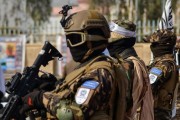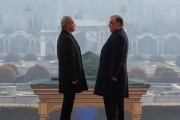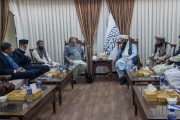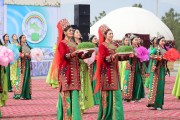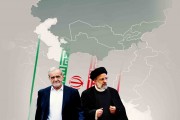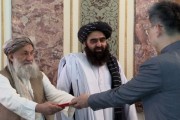Publish Date
Tuesday 26 April 2022 - 07:53
recommended
0
Taliban government and challenge of political networks’ structure
The power networks exist in all societies. In modern societies, the power networks have specific rules and patterns of behavior, and operate within a defined framework. However, in traditional societies such as Afghanistan, these networks follow traditional behaviors that are categorized outside the modern formal rules and are in line with the traditional conditions of the country. The structure of networked government in Afghanistan has a long history which goes back to the beginning of the Durrani Empire. This strong tradition was prevalent among the political leaders until the end of the Islamic Republic (2001-2021). The power networks of Afghanistan have secured their interests over the past twenty years through the following methods: Using the master-servant relationship to expand their political activities, rent seeking, and using the existing identity divisions as tools to create political mobilization. It seems that the tradition of power networks in Afghanistan is dependent on the previous path and the Taliban can hardly cross it. Therefore, it is necessary to adopt a new strategy towards this tradition, and the model of the Musahiban can be one of the appropriate models.
By: Mohammad Safari
Introduction
There are various analyses regarding governance in Afghanistan that have examined the issue of governance and ruling in the country from different perspectives. However, few have addressed the issue of governance in Afghanistan in terms of a networked structure. In general, the structure of the networked government in Afghanistan has a long history and goes back to the beginning of the Durrani Empire. This strong tradition was prevalent among the political leaders until the era of the Islamic Republic (2001-2021). This article takes a look at the future of the Islamic Emirate and the challenge of power networks. The article also question whether the Islamic Emirate can ignore the tradition of the networked structure in Afghanistan. The data in this article also show that the tradition of power networks’ structure in Afghanistan is dependent on a previous path and the Taliban can hardly cross it. Therefore, it is necessary for the Islamic Emirate to adopt a new strategy. This article first briefly introduces the power networks, then examines the history of the networked power structure in Afghanistan and investigates this structure during the Republic and finally discusses the future perspective of the Islamic Emirate and the challenges of power networks.
The power networks
The power networks exist in all societies. In modern societies, the power networks have specific rules and patterns of behavior, and operate within a defined framework. However, in traditional societies such as Afghanistan, these networks follow traditional behaviors that are categorized outside the modern formal rules and are in line with the country's traditional conditions.
The power networks are a number of institutions with hierarchical structure. The structure of these networks is informal, and their members are interdependent on each other's sources and connections. Membership in these networks is fluid. At the time of immediate international intervention in post-conflict countries, when formal institutions have either been weakened or eliminated altogether, the existing power networks will play an important role in rebuilding the post-conflict government.
The power networks of Afghanistan have secured their interests over the past twenty years through the following methods: Using the master-servant relationship to expand their political activities; rent seeking and opportunism; and using the existing identity divisions as tools to create political mobilization.
The history of power networks’ structure in Afghanistan
The Durrani rulers in Afghanistan established a networked kingdom consisting of a small group of family lineages. During the times of disunity and crisis, this small group used the identity and provocative features of the Afghan society to maintain and expand its power in the government. The heads of tribes were very skilled at mobilizing the rebels as a political tool in a bid to remind the king that they were one of the important players of the game, and therefore the king should consult with them constantly. So, it could be said that the king's power was dependent on the tribes’ support as well as maintaining a good network balance between them. The survival of the first Durrani kings, Ahmad Shah and his successor Timur Shah, as well as the first Mohammadzai king, Dost Mohammad Khan, was largely dependent on their ability to maintain a balance between the rival networks. Shah Shujah, Zaman Shah and Sher Ali Khan tried to concentrate the power by weakening the role of tribal leaders, but they failed to balance the political networks and paved the way for the fall of their governments.
Through their discriminatory and divisive social policies, the Afghan kings were creating identity-economic crises. It is interesting to note that the political relations during the process of state-building that happened after 2001 was also the same. Therefore, it can be said that the Pashtun rulers in Afghanistan established a kind of networked government that has been strengthened by power relations between the lineage network of rival tribes, and it led to a vicious cycle of violence and fall of the governments. Moreover, the political disorder has always been rooted in the personal master-servant methods as well as instrumental use of identity diversity. According to the Durrani rulers, the stability of the government had been entirely dependent on the continuation of the tribal leaders’ support as well as the establishment of a good balance between the tribal leaders. Therefore, the government had always provided the political framework for network competition, and it had been in this competition that each faction or political network had used government power and capacity to eliminate its rivals. Here, it is necessary to mention that one of the reasons behind the fall of Amanullah Khan was his policy of centralizing the government; because he sought to weaken the tribal leaders and their affiliated political networks, which made the tribal leaders not to support Amanullah Khan during Habibullah Kalakani's attack on Kabul. Thus, it can be concluded that the tradition of political networks was created during the Durrani monarchy, and the government had to pay ransom to these political networks, which had ethnic and tribal origins, in order to maintain its sovereignty. If any government decides to shatter this tradition, it would actually pave the way for its own collapse. Thus, the structure of power networks which was created as a kind of dependence on the previous path was a major challenge for the next governments.
The structure of power networks during the Republic
A few weeks after the 9/11 attacks, the United States began its Operation Enduring Freedom (OEF) to oust the Taliban. Two months later, the Taliban had virtually lost the control of most parts of the country. Then, the Bonn Conference was begun; and many believe that this conference determined the winner and loser networks. The Pashtun political networks were identified as losers of the war, and the Northern Alliance networks were recognized as winners. The outcome of the Bonn Conference led to further conflict between the existing networks over the master-servant practices and identity policies. Ali Ahmad Jalali, a western-educated politician and former Afghan interior minister, said: "the monopoly of power by the Northern Alliance aggravated the concerns regarding the ethnic balance in the post-Taliban government." Following the sudden evacuation of Kabul by the Taliban, Jamiat-e Islami and its military wing took over the city, and immediately took control of Afghan administrations. The data compiled by the Office of the President show that, under the Bonn Agreement, the monopoly of power took place not only at the ministerial level but also at the level of the Afghan government, such as the army and police departments. The evidence show that the bargaining methods of the political networks as well as the identity disputes have shaped the routine policy of state-building after 2001.
Thus, the government which was formed after 2001 was the result of a political reconciliation rivalry between the rival political networks. Afghan government bureaucracy took on a completely political form because the employees of the administration were not the employees of the government but the employees of political networks who had given them those government posts. As a result, the political networks could use their connections within the government in order to expand and secure their interests, through directing the process of government formation and the process of international state-building. As mentioned earlier, distribution of power at the Bonn Conference was turned into the source of intense competition between the various political networks within the government- despite Hamid Karzai made efforts to consolidate power. For example, we can refer to the pro-western technocrats that gathered around Karzai, whose power was limited to Kabul. These technocrats, along with Karzai, pursued a policy of repression and compromise to consolidate the government’s power.
The years from 2002 to 2004 were a period of networked rivalry among the western-educated Pashtuns, the technocrats led by Karzai and his close allies - such as Ali Ahmad Jalali, Ashraf Ghani, Anwar ul-Haq Ahady- and the Northern Alliance networks which came to power immediately after 2001. Eventually, Karzai realized that he had to compromise with the political networks because he did not have the necessary tools to implement a repressive policy. Moreover, one of the reasons Karzai turned again to the political networks of the Northern Alliance was the issue of the 2004 presidential election, because Karzai could win the presidency through the political networks’ master-servant relations and identity diversity. The remarks by Molavi Tarakhil can prove this argument. Before the 2004 elections, he promised 50,000 votes for Karzai. "I am doing this because I will receive money and land from the government, and Karzai is the only one who can support me and provide security for me," Tarakhil said.
On the other hand, Ashraf Ghani tried to disrupt the structure of political networks in Afghanistan, but as Timor Sharan (who has written a book about the networked government) puts it: “he did not have the iron axe to break the horns of the political networks’ leaders.” This means that Ashraf Ghani did not have the necessary facilities to fight against political networks and even he himself had created a powerful network consisting of his own allies.
The Islamic Emirate and the challenge of networked government
Political history in Afghanistan shows that governance has been shaped through interactions between the rival political networks, and whenever a network has been deprived or excluded from the power structure, it has obstructed the implementation of law and government’s policies. After the fall of Kabul to the Taliban, the group could take control of all areas of Kabul within a day. After the announcement of the cabinet by the Islamic Emirate, other ethnic groups were effectively removed from the power structure. This mono-ethnic government can lead to a legitimacy crisis for the Islamic Emirate, and this crisis provides the conditions for the political networks outside the power structure to use their master-servant relations and identity diversity in order to fight against the Taliban’s rule. Before the civil war, the non-Pashtun political networks did not have a significant role in political games, but the circumstances of the civil war made the Tajik, Uzbek and Hazara political networks to play an important role in political games, especially after the Bonne Agreement which gave the biggest role to the Northern Alliance networks.
Even if the Taliban give a share to the non-Pashtun tribes, it still faces the challenge of political networks within the Pashtun areas, because the historical tradition of governance in Afghanistan is tied to the structure of political networks. For example, during the presidency of President Hamid Karzai, he was more sympathetic to some Pashtun tribes and, in contrast, some tribes were deprived of the power and its facilities. This issue forced these tribes to provide the necessary military force for the Taliban. This example shows that the Islamic Emirate faces the challenge of a networked government structure even within the Pashtun areas and other parts of Afghanistan. If the Taliban government does not take an appropriate policy in this regard, it will face a legitimacy crisis as well as the wrath of various political networks. An inclusive government can help to reduce the level of violence between the Taliban government and non-Pashtun political networks. However, the most important thing is that the Taliban must pursue a long-term strategy towards these political networks. For example, the strategy of the Musahiban rule (1929-1973) towards the political networks could be a good option for the Taliban in this regard. The Musahiban managed to bring a period of calm to Afghanistan through creating a good balance between the political networks. Therefore, the Taliban can adopt the same strategy and deal with the political networks in accordance with today’s situation.
Conclusion
The historical tradition of governance in Afghanistan is tied to the political networks. Throughout the history of modern Afghanistan, these networks have always used the existing master-servant relationship as well as the identity diversity tools to stand up against the central government and seek more power. After the civil war, the non-Pashtun political networks emerged as important players in the power structure. Following the Taliban's takeover of Kabul and the announcement of a mono-ethnic cabinet by the group, speculation about illegitimacy and conflict between the Islamic Emirate and non-Pashtun political networks has increased. Therefore, the Taliban government needs a proper strategy regarding these networks. Sharing other ethnic groups in power may be a good option, but, in the long run, the Taliban government needs to adopt a strategy of balancing political networks.
Mohammad Safari, is a Master of Political Science
Introduction
There are various analyses regarding governance in Afghanistan that have examined the issue of governance and ruling in the country from different perspectives. However, few have addressed the issue of governance in Afghanistan in terms of a networked structure. In general, the structure of the networked government in Afghanistan has a long history and goes back to the beginning of the Durrani Empire. This strong tradition was prevalent among the political leaders until the era of the Islamic Republic (2001-2021). This article takes a look at the future of the Islamic Emirate and the challenge of power networks. The article also question whether the Islamic Emirate can ignore the tradition of the networked structure in Afghanistan. The data in this article also show that the tradition of power networks’ structure in Afghanistan is dependent on a previous path and the Taliban can hardly cross it. Therefore, it is necessary for the Islamic Emirate to adopt a new strategy. This article first briefly introduces the power networks, then examines the history of the networked power structure in Afghanistan and investigates this structure during the Republic and finally discusses the future perspective of the Islamic Emirate and the challenges of power networks.
The power networks
The power networks exist in all societies. In modern societies, the power networks have specific rules and patterns of behavior, and operate within a defined framework. However, in traditional societies such as Afghanistan, these networks follow traditional behaviors that are categorized outside the modern formal rules and are in line with the country's traditional conditions.
The power networks are a number of institutions with hierarchical structure. The structure of these networks is informal, and their members are interdependent on each other's sources and connections. Membership in these networks is fluid. At the time of immediate international intervention in post-conflict countries, when formal institutions have either been weakened or eliminated altogether, the existing power networks will play an important role in rebuilding the post-conflict government.
The power networks of Afghanistan have secured their interests over the past twenty years through the following methods: Using the master-servant relationship to expand their political activities; rent seeking and opportunism; and using the existing identity divisions as tools to create political mobilization.
The history of power networks’ structure in Afghanistan
The Durrani rulers in Afghanistan established a networked kingdom consisting of a small group of family lineages. During the times of disunity and crisis, this small group used the identity and provocative features of the Afghan society to maintain and expand its power in the government. The heads of tribes were very skilled at mobilizing the rebels as a political tool in a bid to remind the king that they were one of the important players of the game, and therefore the king should consult with them constantly. So, it could be said that the king's power was dependent on the tribes’ support as well as maintaining a good network balance between them. The survival of the first Durrani kings, Ahmad Shah and his successor Timur Shah, as well as the first Mohammadzai king, Dost Mohammad Khan, was largely dependent on their ability to maintain a balance between the rival networks. Shah Shujah, Zaman Shah and Sher Ali Khan tried to concentrate the power by weakening the role of tribal leaders, but they failed to balance the political networks and paved the way for the fall of their governments.
Through their discriminatory and divisive social policies, the Afghan kings were creating identity-economic crises. It is interesting to note that the political relations during the process of state-building that happened after 2001 was also the same. Therefore, it can be said that the Pashtun rulers in Afghanistan established a kind of networked government that has been strengthened by power relations between the lineage network of rival tribes, and it led to a vicious cycle of violence and fall of the governments. Moreover, the political disorder has always been rooted in the personal master-servant methods as well as instrumental use of identity diversity. According to the Durrani rulers, the stability of the government had been entirely dependent on the continuation of the tribal leaders’ support as well as the establishment of a good balance between the tribal leaders. Therefore, the government had always provided the political framework for network competition, and it had been in this competition that each faction or political network had used government power and capacity to eliminate its rivals. Here, it is necessary to mention that one of the reasons behind the fall of Amanullah Khan was his policy of centralizing the government; because he sought to weaken the tribal leaders and their affiliated political networks, which made the tribal leaders not to support Amanullah Khan during Habibullah Kalakani's attack on Kabul. Thus, it can be concluded that the tradition of political networks was created during the Durrani monarchy, and the government had to pay ransom to these political networks, which had ethnic and tribal origins, in order to maintain its sovereignty. If any government decides to shatter this tradition, it would actually pave the way for its own collapse. Thus, the structure of power networks which was created as a kind of dependence on the previous path was a major challenge for the next governments.
The structure of power networks during the Republic
A few weeks after the 9/11 attacks, the United States began its Operation Enduring Freedom (OEF) to oust the Taliban. Two months later, the Taliban had virtually lost the control of most parts of the country. Then, the Bonn Conference was begun; and many believe that this conference determined the winner and loser networks. The Pashtun political networks were identified as losers of the war, and the Northern Alliance networks were recognized as winners. The outcome of the Bonn Conference led to further conflict between the existing networks over the master-servant practices and identity policies. Ali Ahmad Jalali, a western-educated politician and former Afghan interior minister, said: "the monopoly of power by the Northern Alliance aggravated the concerns regarding the ethnic balance in the post-Taliban government." Following the sudden evacuation of Kabul by the Taliban, Jamiat-e Islami and its military wing took over the city, and immediately took control of Afghan administrations. The data compiled by the Office of the President show that, under the Bonn Agreement, the monopoly of power took place not only at the ministerial level but also at the level of the Afghan government, such as the army and police departments. The evidence show that the bargaining methods of the political networks as well as the identity disputes have shaped the routine policy of state-building after 2001.
Thus, the government which was formed after 2001 was the result of a political reconciliation rivalry between the rival political networks. Afghan government bureaucracy took on a completely political form because the employees of the administration were not the employees of the government but the employees of political networks who had given them those government posts. As a result, the political networks could use their connections within the government in order to expand and secure their interests, through directing the process of government formation and the process of international state-building. As mentioned earlier, distribution of power at the Bonn Conference was turned into the source of intense competition between the various political networks within the government- despite Hamid Karzai made efforts to consolidate power. For example, we can refer to the pro-western technocrats that gathered around Karzai, whose power was limited to Kabul. These technocrats, along with Karzai, pursued a policy of repression and compromise to consolidate the government’s power.
The years from 2002 to 2004 were a period of networked rivalry among the western-educated Pashtuns, the technocrats led by Karzai and his close allies - such as Ali Ahmad Jalali, Ashraf Ghani, Anwar ul-Haq Ahady- and the Northern Alliance networks which came to power immediately after 2001. Eventually, Karzai realized that he had to compromise with the political networks because he did not have the necessary tools to implement a repressive policy. Moreover, one of the reasons Karzai turned again to the political networks of the Northern Alliance was the issue of the 2004 presidential election, because Karzai could win the presidency through the political networks’ master-servant relations and identity diversity. The remarks by Molavi Tarakhil can prove this argument. Before the 2004 elections, he promised 50,000 votes for Karzai. "I am doing this because I will receive money and land from the government, and Karzai is the only one who can support me and provide security for me," Tarakhil said.
On the other hand, Ashraf Ghani tried to disrupt the structure of political networks in Afghanistan, but as Timor Sharan (who has written a book about the networked government) puts it: “he did not have the iron axe to break the horns of the political networks’ leaders.” This means that Ashraf Ghani did not have the necessary facilities to fight against political networks and even he himself had created a powerful network consisting of his own allies.
The Islamic Emirate and the challenge of networked government
Political history in Afghanistan shows that governance has been shaped through interactions between the rival political networks, and whenever a network has been deprived or excluded from the power structure, it has obstructed the implementation of law and government’s policies. After the fall of Kabul to the Taliban, the group could take control of all areas of Kabul within a day. After the announcement of the cabinet by the Islamic Emirate, other ethnic groups were effectively removed from the power structure. This mono-ethnic government can lead to a legitimacy crisis for the Islamic Emirate, and this crisis provides the conditions for the political networks outside the power structure to use their master-servant relations and identity diversity in order to fight against the Taliban’s rule. Before the civil war, the non-Pashtun political networks did not have a significant role in political games, but the circumstances of the civil war made the Tajik, Uzbek and Hazara political networks to play an important role in political games, especially after the Bonne Agreement which gave the biggest role to the Northern Alliance networks.
Even if the Taliban give a share to the non-Pashtun tribes, it still faces the challenge of political networks within the Pashtun areas, because the historical tradition of governance in Afghanistan is tied to the structure of political networks. For example, during the presidency of President Hamid Karzai, he was more sympathetic to some Pashtun tribes and, in contrast, some tribes were deprived of the power and its facilities. This issue forced these tribes to provide the necessary military force for the Taliban. This example shows that the Islamic Emirate faces the challenge of a networked government structure even within the Pashtun areas and other parts of Afghanistan. If the Taliban government does not take an appropriate policy in this regard, it will face a legitimacy crisis as well as the wrath of various political networks. An inclusive government can help to reduce the level of violence between the Taliban government and non-Pashtun political networks. However, the most important thing is that the Taliban must pursue a long-term strategy towards these political networks. For example, the strategy of the Musahiban rule (1929-1973) towards the political networks could be a good option for the Taliban in this regard. The Musahiban managed to bring a period of calm to Afghanistan through creating a good balance between the political networks. Therefore, the Taliban can adopt the same strategy and deal with the political networks in accordance with today’s situation.
Conclusion
The historical tradition of governance in Afghanistan is tied to the political networks. Throughout the history of modern Afghanistan, these networks have always used the existing master-servant relationship as well as the identity diversity tools to stand up against the central government and seek more power. After the civil war, the non-Pashtun political networks emerged as important players in the power structure. Following the Taliban's takeover of Kabul and the announcement of a mono-ethnic cabinet by the group, speculation about illegitimacy and conflict between the Islamic Emirate and non-Pashtun political networks has increased. Therefore, the Taliban government needs a proper strategy regarding these networks. Sharing other ethnic groups in power may be a good option, but, in the long run, the Taliban government needs to adopt a strategy of balancing political networks.
Mohammad Safari, is a Master of Political Science
News code:3060






